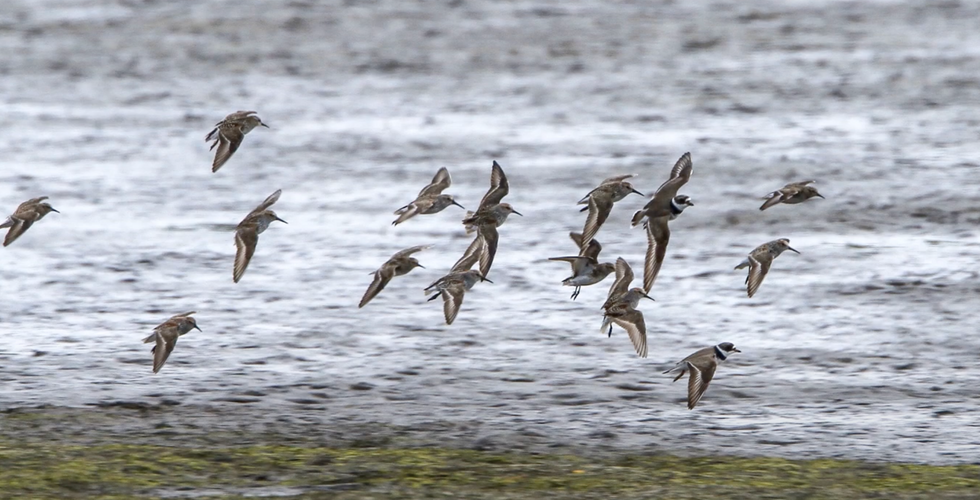Special Features of the Edmonds Marsh Watershed
- Mika

- Oct 2, 2023
- 4 min read
Updated: Dec 6, 2023
The Edmonds Marsh Watershed has many special features that make it especially worth protecting. The marsh itself is clearly something that makes this area special, but in this post, 5 more special features are highlighted.
1. Ecological refuge
The Edmonds Marsh is a major stop along bird migratory routes. Over 90 species of birds stop through throughout the year, making this a critical habitat (Edmonds Marsh, n.d.). Many of the birds hunt for fish in the marsh and wade in the water, so any pollution upstream of this marsh has the potential to harm birds in this habitat. Bill Anderson was a devoted marsh advocate and photographed many of these bird species at the marsh (City of Edmonds, 2020). A few of his photos are shown below.
The marsh is one of the few remaining saltwater marshes remaining in the urban Puget Sound area, making it important as fish habitat as well (Edmonds Marsh through Time, n.d.). Native salmon historically used the marsh but now are largely unable to access it due to a long culvert which connects the marsh to the Puget Sound. The Willow Creek Fish Hatchery is located just southeast of the marsh, and releases over 80,000 salmon each year in the greater Western Washington area (Willow Creek Salmon & Watershed Education Center, n.d.). Willow Creek feeds directly into the marsh and is likewise affected by the health of the watershed. Beyond this, coyotes and deer frequent the marsh and other areas of the watershed in search of food and habitat.

2. Educational resource
The Edmonds Marsh and the Willow Creek Fish Hatchery serve as important educational resources and places for people to access nature (Edmonds Marsh, n.d.). The Marsh includes over 300 ft of boardwalk and 4 interpretive signs to help people learn more about the marsh, which just 40 years ago was in peril. The marsh is also a popular destination for school field trips and acts as an accessible and free way for people to interact with nature.

The Willow Creek Fish Hatchery, also located within this watershed, likewise serves as an educational resource for the community. This facility has community classrooms available to rent, walking trails along Willow Creek, and a native plant garden (Willow Creek Salmon & Watershed Education Center, n.d.). They also run a program called Salmon in Schools, which gives salmon eggs to local classrooms to look after as the eggs hatch. The classes eventually release the baby salmon into a local stream. Educating the classes about salmon and barriers to salmon survival is an important part of the program and helps contribute to better long-term health of the watershed.
3. Cultural heritage
Prior to European settlement, the Edmonds Marsh was commonly used as an area for the local Coast Salish Tribes to fish, gather shellfish, and harvest plants which were used to make clothing, mats, and baskets (Edmonds Marsh through Time, n.d.). This tradition continues to be protected today under Tribal fishing rights, though the damaged health of the marsh from years of neglect limits the cultural resources that were once found in this area.

4. Community-supported restoration
The Edmonds Marsh has drawn widespread community support, giving rise to a few organizations which are devoted to restoring the Edmonds Marsh. Save our Marsh is one such group, founded by citizens, which seeks to prevent further encroachment of development, support efforts to 'daylight' the portion of Willow Creek which is currently running through a fish-impassable culvert, encourage the incorporation of the best available science into decision-making, and improve water quality for the betterment of the marsh and Puget Sound (Save our Marsh, n.d.). The Edmonds Marsh Estuary Advocates are another community-led group which seeks to encourage the sale of an adjacent property which was historically marshland to the City of Edmonds to nearly double the size of the marsh, call for the daylighting of Willow Creek, pursue funding to help support marsh health, and plant native species (Our Mission, n.d.).

These organizations and the city government, which owns the marsh property, host many invasive species removal parties and planting events to further get the community involved in the marsh. This has helped make restoring the marsh a city priority.
5. Residential neighborhoods surrounding ecosystem
One last special feature of this watershed is how mixed use it is. The Edmonds Marsh and the creeks that feed it are surrounded by residential areas and part of the popular downtown corridor. This gives rise to a major challenge of this watershed—there are such delicate ecosystems within this area, yet it is highly developed. Creating ways for these to exist in harmony is crucial to building long-term health in the marsh and Willow Creek, both of which provide important habitat. However, it is also a great opportunity to offer an ecological resource where there otherwise would not be one. Many similar marshes are now completely lost to development, making the protection of this marsh especially important.

References
City of Edmonds. (2020, September 15). Edmonds Marsh Four Seasons. YouTube. https://www.youtube.com/watch?v=Gfhx2S32zNY
Edmonds Marsh. (n.d.). City of Edmonds. Retrieved October 2, 2023, from https://www.edmondswa.gov/government/departments/parks_and_recreation/programs__classes_and_camps/discovery_programs/explore_discovery_places/edmonds_marsh
Edmonds Marsh Through Time. (n.d.). Sierra Club. Retrieved October 2, 2023, from https://www.sierraclub.org/washington/edmonds-marsh-through-time
Our Mission. (n.d.). Edmonds Marsh Estuary Advocates. Retrieved October 2, 2023, from https://www.edmondsmarshestuary.org/missiostatement
Save our Marsh. (n.d.). About Save the Edmonds Marsh. Facebook. Retrieved October 2, 2023, from https://www.facebook.com/SaveTheEdmondsMarsh/about_details
Willow Creek Salmon & Watershed Education Center. (n.d.). Sound Salmon Solutions. Retrieved October 2, 2023, from https://www.soundsalmonsolutions.org/wcswec































